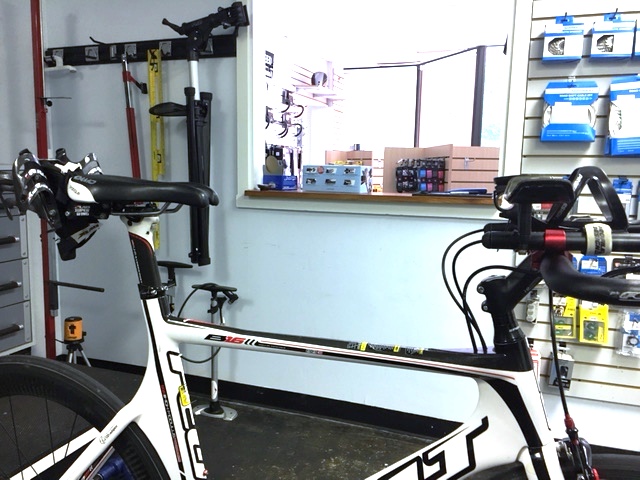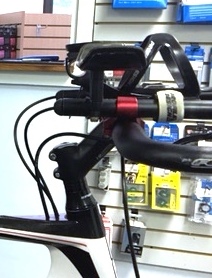Don't Throw Out Your Tri Bike Just Yet- You May Need It
Posted by Matt Russ on 25th Apr 2016
 One of the myths and misconceptions I often find myself dispelling is that a triathlon bike is faster because it is more aerodynamic than other bikes. The aerodynamic drag of any bike is small when in comparison to the rider and their accessories, which accounts for up to 90% of the drag. The actual performance gain between a tri bike and a road bike from reduction of aerodynamic drag is actually very, very small. It is so small as to be inconsequential in comparison to other factors that can be easily and cheaply manipulated; rider position being the biggest.
One of the myths and misconceptions I often find myself dispelling is that a triathlon bike is faster because it is more aerodynamic than other bikes. The aerodynamic drag of any bike is small when in comparison to the rider and their accessories, which accounts for up to 90% of the drag. The actual performance gain between a tri bike and a road bike from reduction of aerodynamic drag is actually very, very small. It is so small as to be inconsequential in comparison to other factors that can be easily and cheaply manipulated; rider position being the biggest.
The true value of a tri bike is that...
- Overall drag is reduced by a more compact rider position.
- A lower torso angle is achievable.
- The bike handles safely and ergonomically in the aero position.
In my experience there is a big difference between a triathlon store, and a bike store that sells tri bikes when it comes to fitting. Take the bike pictured at the right for instance, this bike was set up in 30 minutes at a aforementioned bicycle store that sells tri bikes. One of the things that I measure is "drop" or the vertical distance from the top of the saddle to the aerobar pads. Drop roughly estimates torso angle which is the biggest producer of aerodynamic drag. In this case the rider was positioned with his elbows above the saddle. In others words there was no drop.
Unfortunately the money spent to replace his road bike was largely wasted. In fact he likely would have been faster on his road bike in the drops which are well below the saddle. The bike will also be less stable in the aerobars as the center of gravity is too high, higher than the bike was actually designed for. Now it could be said that this is a more comfortable position; generally a higher position produces less discomfort in the back and neck. But the same argument could be made for a beach cruiser over a road bike. The cruiser will be more comfortable but a lot slower!
 Before making the jump from a road bike to a tri bike I like the athlete to be able to spend the majority of their time when not climbing in the drops. This begins to acclimate them to the lower torso angle of a tri bike. Clip-on aerobars are a cheap interim step to allow the athlete to get used to the aero position without purchasing a new bike. But they are just that- an interim step, and a road bike should not pounded into the tri bike hole. If the athletes main objective is performance gain my preferred process it to take them lower in stages of a few centimeters at a time. This allows the muscles to stretch, strengthen, and acclimate over time. There are instances where a more upright tri position is warranted; such as an athlete with low back injury, degenerative disc, or cervical nerve impingement. The goal of a fitting should be to find the right mix of comfort, leverage of power, and aerodynamics for the individual.
Before making the jump from a road bike to a tri bike I like the athlete to be able to spend the majority of their time when not climbing in the drops. This begins to acclimate them to the lower torso angle of a tri bike. Clip-on aerobars are a cheap interim step to allow the athlete to get used to the aero position without purchasing a new bike. But they are just that- an interim step, and a road bike should not pounded into the tri bike hole. If the athletes main objective is performance gain my preferred process it to take them lower in stages of a few centimeters at a time. This allows the muscles to stretch, strengthen, and acclimate over time. There are instances where a more upright tri position is warranted; such as an athlete with low back injury, degenerative disc, or cervical nerve impingement. The goal of a fitting should be to find the right mix of comfort, leverage of power, and aerodynamics for the individual.
The owner of the bike pictured spent a few hundred dollars on his fit. Aerodynamically speaking this is the best ROI he can achieve. It will offer greater return than an complete upgrade of his groupo, a $3000 set of wheels, even a $5000 new bike! If you have upgraded to a tri bike and have not realized an appreciable performance gain don't throw out your tri bike. Remember that the bike is designed to allow the position that will gain you performance; it does not represent a performance gain in and of itself.


